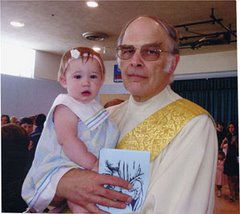John 20:19 - 31
One of the many joys of being a
grandfather is that you can get away with telling your young
grandchildren fantastic stories and they believe you! We all go
through that stage where we do not doubt. I have a memory of when I
was about three or four, when I was teased by my grandfather and one
of his friends. They insisted that I had a tail, and all I had to do
was turn around and I could see it. But of course the more I turned,
the region in which the tail was supposed to be also turned. I did
not doubt, though.
Probably every Christian has a little
sympathy for Thomas, who because of this short gospel story, has been
known as the Doubter for two thousand years. Thomas who said to the
other disciples, “Let us go down to Jerusalem with him to die with
him”. Thomas who probably traveled as far as Paul did, founding
churches up and down the gulf of Arabia and into India. Thomas who
died a martyr. And I think we misinterpret Christ's words to him:
“Thomas, you have believed because you have seen; blessed are those
who have not seen, but believe.” It is not a rebuke of Thomas, I
think, but rather, a recognition of the fact that believers are that
way because of a special grace from God. John makes it clear in his
gospel that belief is a gift, not something that comes about because
you've reasoned to it. Belief, even that of Thomas, is always a
gift. But I'd like to look at something else today.
Why do the gospel writers record the
resurrection appearances that they do? According to John and Paul
Jesus appeared many other times; and if we believe Sister Faustina,
He continues to appear to some of his followers even today. So why
these appearances? It isn't just to impress us, or convince us that
Jesus rose from the dead. One purpose is to show us where we can
find Jesus.
The first point made by all the
writers is that if you look into the tomb, you will not find Jesus.
The angel emphasizes this: Why are you looking for the living one
among the dead? The tomb is empty and it is a promise to us that our
tombs will be empty some day. Perhaps it reminds us not to regard
Jesus as someone “up there” who no longer moves among his people.
The second point is that for many of
the appearances Jesus is at first not recognized. In Luke, when
Jesus appears to the twelve,“They thought He was a ghost.” Jesus
has to convince them that he really has risen from the dead by
showing them his wounds and eating something. And you remember the
other appearances. Mary Magdalene doesn't recognize Jesus until he
calls her by name. The two disciples on the way to Emmaus don't
recognize him until he breaks bread with them. When the seven
apostles describe in John go fishing in Galilee, eventually the
Beloved disciple, the one who previously believed because of his
great love, recognizes Jesus first, and this triggers recognition in
the others. What does all this mean? I think it means that the
Risen Jesus is with us; we don't see Him most of the time. If we
did, we would not have a need for faith; we would not be able to make
a choice; and Jesus wants us to choose to love him, not force it on
us.
But he is with us nonetheless. When
we read the gospel story today, we should note that John has Jesus
appearing among his disciples on the first day of the week, and again
on the eighth day. That is deliberate. John wants us to note that
Jesus can be found in the assembly of believers; among those who come
together to worship. Jesus himself told us that when two or three
are gathered in his name, there he was.
When we remember the two disciples on
the way to Emmaus, we should note that as they rushed back to tell
the apostles of the fact that they had met the Risen Lord, they spoke
about how their hearts were burning within them as he interpreted the
scriptures for them. Jesus is present in the scriptures,
specifically, when they are being interpreted, when they are being
read prayerfully and with the help of the Holy Spirit. It is so
unfortunate when Christians don't read the scriptures, or read them
superficially, or read them as some kind of text book. Truly, they
should read them together, perhaps in small groups, because the
meaning is not in the mere words but is in the interpretation of
those words. Someone once said that the bible is not inspired until
it is read by someone with the help of the Holy Spirit.
In the time after the Resurrection
Jesus is recognized by the Emmaus disciples and by the seven
disciples on the shore in the breaking of the bread. We Catholics
hold that in the Mass the bread and the wine become the body and
blood of Christ, as do many other Christian bodies. And there are
Christian bodies who do not believe that. Some believe that the
bread and wine remain, but Jesus becomes present; some believe that
the action is only a symbol; and there are some, like the Mormons,
who don't even believe you need bread and wine, because the acting
out of a sacred meal is all that matters. But every Christian body
has a ritual in which they try to carry out Jesus' command, to do
this in memory of him; and that is the third place we can find Jesus;
in the breaking of the bread in his memory.
Every Christian can seek the presence
of Jesus in the assembly of fellow Christians, in the scriptures
prayerfully read and studied; and in the breaking of the bread. And
there are two more situations where Jesus can be discovered. One is
when he is sought with deep love. We see this in Mary Magdalene, who
weeps at the tomb, who cries out, “where have you taken my Lord?”
And Jesus answers by speaking her name – the shepherd calls his
sheep by name. The Beloved Disciple on seeing the empty tomb,
believes because of his great love, in circumstances when Peter only
wonders.
And the other, I think, is when a
committed Christian struggles with doubt. To read the whole story of
Thomas shows that he is as much a true disciple of Jesus as the rest
of them; both before and after the Resurrection. But Thomas has
honest doubts, and the Lord knows that doubt is part of being human.
Mother Theresa reported to her confessor that most of her life she
struggled with doubt; and yet she is a saint. Doubt is normal, and
when we face our doubt, when we realize that a condition for faith is
doubt, (because when we are certain of something it's no longer
faith), it is then the Jesus shows us his hands and feet, and invites
us to touch him and doubt no longer.
Jesus has risen from the dead. He is
already here among us. He has shown us where to find him. And
sadly, some of us will not bother to look for him.



































